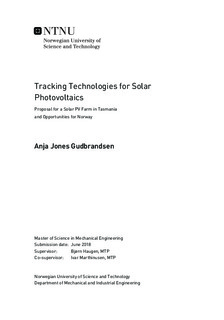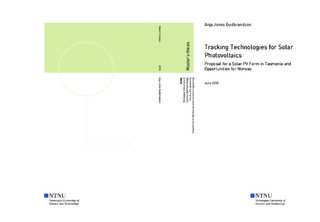| dc.description.abstract | This thesis assesses the suitability of three large scale solar PV tracking technologies for a range of conditions; subtropical, temperate and cold weather climates. Systems evaluated include Fixed Tilt (FT), Single Axis Tracking (SAT) and Dual Axis Tracking (DAT). The importance of establishing the project objectives is emphasized; is it peak power, grid utilization, annual electricity generated or seasonal production that should be optimized? Similarly, understanding site specific characteristics is critical for system selection. The relationship between solar irradiance, ambient temperature, power demand and electricity spot price throughout the year is discussed, as is the importance of understanding how the solar irradiance can vary from predominantly direct to diffuse during the year thus affecting the choice of tracking system.
Traditional project analysis focuses on solar irradiance and weather data when quantifying the efficiency, with fixed electricity prices for the economics. This thesis aims to utilizes real and simulated performance data in combination with actual electricity spot prices to establish both the energy output and financial benefits of the different systems. The methodology presented also incorporates an uncertainty analysis to highlight the risk profiles for the technologies, thereby assisting system selection.
The methodology was first applied for the operating Gatton Solar Research Facility (subtropical, Queensland). Gains in energy output of 20% and 25% for SAT and DAT over FT were achieved, whilst the gain in income was 36% and 40% respectively, emphasizing the importance of daily spot price variations. The results, together with simulations in PVsyst, were used to make recommendations for a new farm in Tasmania (temperate). Thereafter, the findings were transferred to Norway to illustrate solar PV s potential even in a high latitude and cold weather climate.
The advantage of combining solar PV with other energy sources, such as hydro, is discussed together with the potential benefits for including limited battery storage for stabilizing output and exploiting typical over-production at midday. Opportunities for learning from large scale farms in Australia are highlighted in order to benefit from their experience when implementing new technology. The importance of using qualified partners throughout all phases of the project is emphasized.
The research was mainly performed in Australia, where the thriving solar PV industry is only limited by access to the grid and securing a power purchase agreement. A network was established covering the entire value chain from equipment suppliers, EPC contractors, farm owners, certifying institutions, consultancy companies and academia. This was complemented by a similar network in Norway.
This thesis thus provides an unbiased evaluation of tracking systems and their potential, focusing on both technical and economic performance. | |

